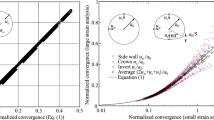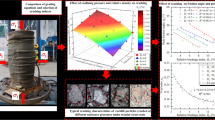Abstract
With the growing demand of mineral consumption, the management of the mining waste is crucial. Cemented paste backfill (CPB) is one of the techniques developed by the mining industry to fill the voids generated by the excavation of underground spaces. The CPB process is the subject of various studies aimed at optimizing its implementation in the field. In this article, we focus on the modelling of the backfill phase where it has been shown in Vigneaux et al. (Cem. Concr. Res. 164:107038, 2023) that a viscoplastic lubrication model can be used to describe CPB experiments. The aim here is to propose an accelerated method for performing the parameters’ estimation of the properties of the paste (typically its rheological properties), with an inverse problem procedure based on observed height profiles of the paste. The inversion procedure is based on a metamodel built from an initial partial differential equation model, thanks to a polynomial chaos expansion coupled with a principal component analysis.






Similar content being viewed by others
Change history
06 March 2024
A Correction to this paper has been published: https://doi.org/10.1007/s00397-024-01441-3
References
Azam S, Li Q (2010) Tailings Dam failures: a review of the last one hundred years. Geotechnical News (Canada USA Mexico), 28(4):50–53. Section: Waste Geotechnics
Balmforth NJ, Craster RV, Rust AC, Sassi R (2006) Viscoplastic flow over an inclined surface. J Nonnewton Fluid Mech 139(1–2):103–127
Berger C, Vigneaux P (2023) Supplementary code for “A metamodel for confined yield stress flows and parameters’ estimation”. Zenodo. https://doi.org/10.5281/zenodo.8377205
Blatman G, Sudret, B (2013) Sparse polynomial chaos expansions of vector-valued response quantities. In: Safety, reliability, risk and life-cycle performance of structures and infrastructures, pp 3245–3252. CRC Press/Balkema
Coussot P, Proust S, Ancey C (1996) Rheological interpretation of deposits of yield stress fluids. J Nonnewton Fluid Mech 66(1):55–70
Garcia-Cabrejo O, Valocchi A (2014) Global sensitivity analysis for multivariate output using polynomial chaos expansion. Reliab Eng Syst Saf 126:25–36
Hadigol M, Doostan A (2018) Least squares polynomial chaos expansion: a review of sampling strategies. Comput Methods Appl Mech Eng 332:382–407
Hawchar L, Soueidy C-PE, Schoefs F (2017) Principal component analysis and polynomial chaos expansion for time-variant reliability problems. Reliab Eng Syst Saf 167:406–416
Hogg AJ, Matson GP (2009) Slumps of viscoplastic fluids on slopes. J Nonnewton Fluid Mech 158(1):101–112
Huang X, Garcia MH (1998) A Herschel-Bulkley model for mud flow down a slope. J Fluid Mech 374:305–333
Jolliffe IT (2002) Principal Component Analysis. Springer Series in Statistics. Springer, 2 edition
Keller EA (2008) Introduction to environmental geology. Pearson Prentice Hall, 4th edition
Landriault D (2006) They Said “It Will Never Work” - 25 Years of Paste Backfill 1981 - 2006. In: Paste 2006: Ninth international seminar on paste and thickened tailings, 2006 3-7 April. Jewell RJ, Lawson S, Newman P (eds), pp 277–292, Limerick, Ireland. Australian Centre for Geomechanics
Le Maître OP, Knio OM (2010) Spectral Methods for Uncertainty Quantification. With Applications to Computational Fluid Dynamics. Scientific Computation, Springer, Netherlands
LeVeque RJ (2004) Finite Volume Methods for Hyperbolic Problems. Cambridge University Press
Liu KF, Mei CC (1989) Slow spreading of a sheet of Bingham fluid on an inclined plane. J Fluid Mech 207:505–529
Liu Y, Balmforth NJ, Hormozi S, Hewitt DR (2016) Two-dimensional viscoplastic dambreaks. J Nonnewton Fluid Mech 238:65–79
Migliorati G, Nobile F (2015) Analysis of discrete least squares on multivariate polynomial spaces with evaluations at low-discrepancy point sets. J Complex 31(4):517–542
Mizani S, He X, Simms P (2013) Application of lubrication theory to modeling stack geometry of high density mine tailings. J Nonnewton Fluid Mech 198:59–70
Nelder JA, Mead R (1965) A Simplex Method for Function Minimization. Comput J 7(4):308–313
Roussel N, Coussot P (2005) “Fifty-cent rheometer” for yield stress measurements: From slump to spreading flow. J Rheol 49(3):705–718
Sudret B (2015) Polynomial chaos expansions and stochastic finite element methods. In: Risk and Reliability in Geotechnical Engineering, pp 265–300. CRC Press
Sun X, Choi YY, Choi J-I (2020) Global sensitivity analysis for multivariate outputs using polynomial chaos-based surrogate models. Appl Math Model 82:867–887
UNCED (1992) Agenda 21: program of action from the United Nations organization. Technical report, United Nations Conference on Environment and Development (UNCED), Rio de Janeiro, Brazil. §11.13, §13.15, §17.28
Vigneaux P, Shao Y, Frigaard IA (2023) Confined yield stress lubrication flows for cement paste backfill in underground stopes. Cem Concr Res 164:107038
Xiu D, Karniadakis GE (2002) The Wiener-Askey polynomial chaos for stochastic differential equations. SIAM J Sci Comput 24(2):619–644
Yilmaz E, Fall M (2017) Paste tailings management. Springer
Zenodo (2013) European Organization For Nuclear Research and OpenAIRE
Acknowledgements
We would like to extend our warmest thanks to Ian Frigaard and Yajian Shao for their fruitful discussions on this work.
This study used components of the SciPy, NumPy, Scikit-learn, Chaospy, Numpoly and Matplotlib Python libraries — we thank the respective authors for making their code free and open source. We gratefully acknowledge support from the PSMN (Pôle Scientifique de Modélisation Numérique) of the ENS de Lyon for the computing resources.
Funding
This research has been conducted with financial support from the French National Research Agency (ANR) through the research project VPFlows, Grant number: ANR-20-CE46-0006. Clément Berger was funded by a CDSN grant from the French MESRI. David Coulette and Paul Vigneaux were funded by the French ANR under grant number ANR-20-CE46-0006.
Author information
Authors and Affiliations
Contributions
Clément Berger: conceptualization, methodology, software, writing. David Coulette: data curation, software. Paul Vigneaux: conceptualization, methodology, software, writing, funding.
Corresponding author
Additional information
Publisher's Note
Springer Nature remains neutral with regard to jurisdictional claims in published maps and institutional affiliations.
Supplementary code on Zenodo, ref 8377205.
The original online version of this article was revised due to incorrect section citation in the Results section.
Appendices
Appendix A. Numerical solver
A.1 Numerical computation of h(t, 0)
As stated in the “2.2” section, the numerical computation of h(t, 0) is not straightforward. The time being fixed, let’s write \(h_1=h(t,\Delta x)\) (known) and \(h_0=h(t,0)\) (unknown). A downwind scheme for \(\partial h/\partial x\) and the boundary condition \(q(0)=1\) together with (1) lead to the following problem on \(h_0\):
with
and
This problem is highly non-linear. However, it is constant equal to 0 whenever \(Y_d(h_0)=0\). On the other part of the real line, it can be checked that the function of \(h_0\) defined by (26) is actually strictly increasing and continuous, implying the uniqueness of the solution of our problem. Because of the power law involved in (26), an external solver is required to numerically solve the problem. In order to accelerate its resolution, we provide to the solver the point after which \(Y_d>0\) (so that it does not get stuck in a constant region). Using (28) and \(h_0\ge 0\), we derive the formula:
Note that in the special case \(n=1\), the problem (26) is equivalent to finding the root of a polynomial of degree 7. However, in practice, it is not faster than using the methodology presented above.
A.2 Numerical stability condition
We develop the expression (1) of the model, so as to obtain explicitly an advection-diffusion form. Denoting V(x) the transport coefficient and D(x) the diffusion coefficient, (1) is equivalent to:
with \(\delta =\text{ sgn }(S-h_x)\),
and
At each time iteration, as mentioned in the main text, the time step is determined as:
where (the classical) \(C_d = 0.5\) ensures stability for most simulations. One can lower \(C_d\), e.g., \(C_d = 0.05\) to stabilize the simulation if needed. Note that for the current paper, where the solutions are not computed after the time of wall-touch, \(C_d = 0.5\) leads to stable simulations for all studied parameters (B, S).
Appendix B. Noisy synthetic profiles
The supplementary figure, mentioned in the main text, concerning the study of noisy profiles with 10% noise.
Comparison between a real height profile (solid line), its noisy version (circle) and the profile determined by the Nelder-Mead algorithm (dotted line). The noisy profiles are created using 10% of noise. The three colors correspond to three different (B, S) used in Fig. 4
Rights and permissions
Springer Nature or its licensor (e.g. a society or other partner) holds exclusive rights to this article under a publishing agreement with the author(s) or other rightsholder(s); author self-archiving of the accepted manuscript version of this article is solely governed by the terms of such publishing agreement and applicable law.
About this article
Cite this article
Berger, C., Coulette, D. & Vigneaux, P. A metamodel for confined yield stress flows and parameters’ estimation. Rheol Acta 63, 251–263 (2024). https://doi.org/10.1007/s00397-024-01436-0
Received:
Revised:
Accepted:
Published:
Issue Date:
DOI: https://doi.org/10.1007/s00397-024-01436-0





